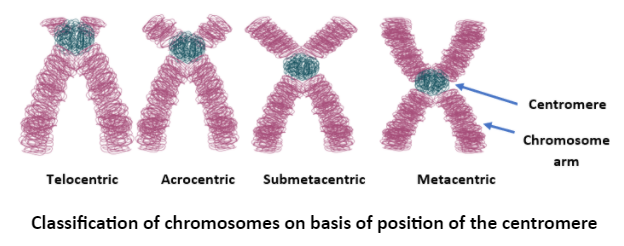
What is centromere? How does the basis of centromere form the basis of classification of chromosomes? Support the answer with a diagram showing the position of centromere on different types of chromosomes?
Answer
573.9k+ views
Hint: A closely packed structure and a very specific portion of the chromosome, and during cell division it has a very important role. It is responsible for the movement during mitosis and meiosis of the replicated chromosomes into the two daughter cells.
Complete answer:

A centromere is a chromosome constricted region which separates it into a short arm and a long arm. The chromosomes first multiply during cell division, so that each daughter cell receives a full set of chromosomes. The chromosome consists of two identical sister chromatids that are connected at the centromere during DNA replication.
The primary role of the centromere is to serve as the kinetochore assembly site, a highly complex multi protein structure responsible for the actual chromosome segregation events, i.e. binding microtubules and signalling to the cell cycle machinery when all chromosomes have proper attachments to the spindle, so that cell division is safe to proceed to completion The centromere is the point on a chromosome where, during cell division, mitotic spindle fibres bind to pull sister chromatids apart.
The chromosomes are primarily categorised on the basis of centromere positions:
> Telocentric: The centromere of the telocentric chromosome is positioned at the terminal end of the chromosome. Consequently, a telocentric chromosome only has one arm. Telomeres can stretch from both ends of the chromosome; their form during anaphase is similar to the letter "i." The typical house mouse karyotype, for example, only has telocentric chromosomes.
> Acrocentric: They are found at the end of a chromosome in these centromeres. Five acrocentric chromosomes are part of the human genome: 13, 14, 15, 21, 22, and the Y chromosome is also acrocentric.
> Submetacentric: They are generally L-shaped and the chromosome is assumed to be submetacentric if the arms' lengths are unequal.
> Metacentric: these are X-shaped chromosomes, the centre of which is the centromere, such that the two chromosome arms are almost identical. A chromosome is metacentric if the length of its two arms is approximately equal. Five chromosomes are found metacentric in the standard human karyotype: chromosomes 1, 3, 16, 19, and 20.
Note: During mitosis and meiosis in eukaryotic cells, centromeres play an important role in proper chromosome segregation. It also assists in the adhesion and separation of sister chromatids, microtubule attachment, chromosome movement, heterochromatin establishment, and regulation of mitotic control points.
Complete answer:

A centromere is a chromosome constricted region which separates it into a short arm and a long arm. The chromosomes first multiply during cell division, so that each daughter cell receives a full set of chromosomes. The chromosome consists of two identical sister chromatids that are connected at the centromere during DNA replication.
The primary role of the centromere is to serve as the kinetochore assembly site, a highly complex multi protein structure responsible for the actual chromosome segregation events, i.e. binding microtubules and signalling to the cell cycle machinery when all chromosomes have proper attachments to the spindle, so that cell division is safe to proceed to completion The centromere is the point on a chromosome where, during cell division, mitotic spindle fibres bind to pull sister chromatids apart.
The chromosomes are primarily categorised on the basis of centromere positions:
> Telocentric: The centromere of the telocentric chromosome is positioned at the terminal end of the chromosome. Consequently, a telocentric chromosome only has one arm. Telomeres can stretch from both ends of the chromosome; their form during anaphase is similar to the letter "i." The typical house mouse karyotype, for example, only has telocentric chromosomes.
> Acrocentric: They are found at the end of a chromosome in these centromeres. Five acrocentric chromosomes are part of the human genome: 13, 14, 15, 21, 22, and the Y chromosome is also acrocentric.
> Submetacentric: They are generally L-shaped and the chromosome is assumed to be submetacentric if the arms' lengths are unequal.
> Metacentric: these are X-shaped chromosomes, the centre of which is the centromere, such that the two chromosome arms are almost identical. A chromosome is metacentric if the length of its two arms is approximately equal. Five chromosomes are found metacentric in the standard human karyotype: chromosomes 1, 3, 16, 19, and 20.
Note: During mitosis and meiosis in eukaryotic cells, centromeres play an important role in proper chromosome segregation. It also assists in the adhesion and separation of sister chromatids, microtubule attachment, chromosome movement, heterochromatin establishment, and regulation of mitotic control points.
Recently Updated Pages
Master Class 11 Business Studies: Engaging Questions & Answers for Success

Master Class 11 English: Engaging Questions & Answers for Success

Master Class 11 Computer Science: Engaging Questions & Answers for Success

Master Class 11 Social Science: Engaging Questions & Answers for Success

Master Class 11 Maths: Engaging Questions & Answers for Success

Master Class 11 Biology: Engaging Questions & Answers for Success

Trending doubts
One Metric ton is equal to kg A 10000 B 1000 C 100 class 11 physics CBSE

Explain zero factorial class 11 maths CBSE

An example of chemosynthetic bacteria is A E coli B class 11 biology CBSE

State the laws of reflection of light

What is 1s 2s 2p 3s 3p class 11 chemistry CBSE

Which one of the following is not a method of soil class 11 biology CBSE




